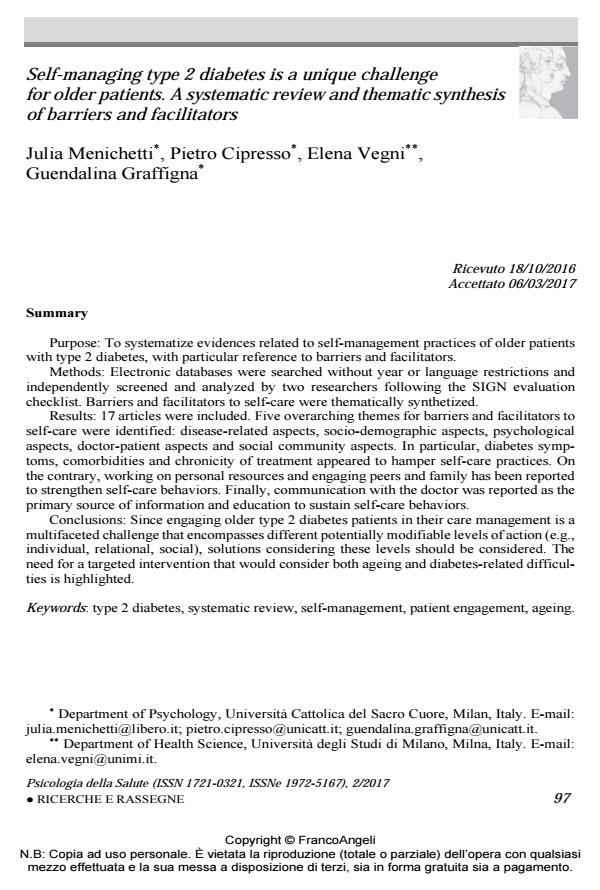Self-managing type 2 diabetes is a unique challenge for older patients. A systematic review and thematic synthesis of barriers and facilitators
Journal title PSICOLOGIA DELLA SALUTE
Author/s Julia Menichetti, Pietro Cipresso, Elena Vegni, Guendalina Graffigna
Publishing Year 2017 Issue 2017/2
Language English Pages 24 P. 97-120 File size 467 KB
DOI 10.3280/PDS2017-002005
DOI is like a bar code for intellectual property: to have more infomation
click here
Below, you can see the article first page
If you want to buy this article in PDF format, you can do it, following the instructions to buy download credits

FrancoAngeli is member of Publishers International Linking Association, Inc (PILA), a not-for-profit association which run the CrossRef service enabling links to and from online scholarly content.
Purpose: To systematize evidences related to self-management practices of older patients with type 2 diabetes, with particular reference to barriers and facilitators. Methods: Electronic databases were searched without year or language restrictions and independently screened and analyzed by two researchers following the SIGN evaluation checklist. Barriers and facilitators to self-care were thematically synthetized. Results: 17 articles were included. Five overarching themes for barriers and facilitators to self-care were identified: disease-related aspects, socio-demographic aspects, psychological aspects, doctor-patient aspects and social community aspects. In particular, diabetes symptoms, comorbidities and chronicity of treatment appeared to hamper self-care practices. On the contrary, working on personal resources and engaging peers and family has been re-ported to strengthen self-care behaviors. Finally, communication with the doctor was reported as the primary source of information and education to sustain self-care behaviors. Conclusions: Since engaging older type 2 diabetes patients in their care management is a multifaceted challenge that encompasses different potentially modifiable levels of action (e.g., individual, relational, social), solutions considering these levels should be considered. The need for a targeted intervention that would consider both ageing and diabetes-related difficulties is highlighted.
Keywords: Type 2 diabetes, systematic review, self-management, patient engagement, ageing.
Julia Menichetti, Pietro Cipresso, Elena Vegni, Guendalina Graffigna, Self-managing type 2 diabetes is a unique challenge for older patients. A systematic review and thematic synthesis of barriers and facilitators in "PSICOLOGIA DELLA SALUTE" 2/2017, pp 97-120, DOI: 10.3280/PDS2017-002005